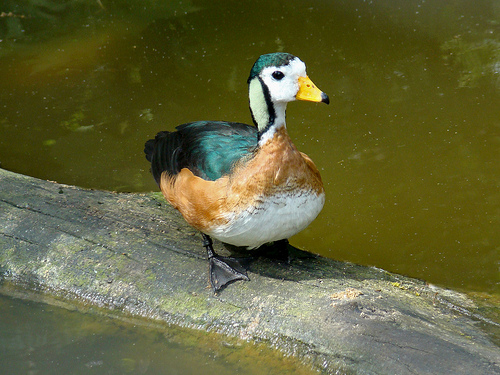
African pygmy goose(Nettapus auritus)
Phylum —chordata
Class — aves
Order — anseriformes
Family — anatidae
Genus –nettapus
Appearance
The African pygmy goose is one of the smallest of the perching ducks, and it has the average weight of about 285 grams (10.1 oz) for males and 260 grams (9.2 oz) for females and wingspans between 142 millimeters (5.6 in) and 165 millimeters (6.5 in).
They have a short bill which extends up the forehead so they superficially resemble geese.
The males have a white face with black eye patches. The iridescent black crown extends down the back of the neck. The upper half of the fore neck is white and forms an open collar around the neck whereas the base if the neck and breast are light chestnut colored. The flanks are more intensely chestnut colored and the back is metallic green. The sixteen tail feathers are black. The wing feathers are black with metallic green iridescence on the coverts, with the exemption of a white bar on the distal secondaries. The belly is white. The bill is yellow with a black tip and the feet are dark-gray to black. The iris of there is reddish brown.
The females have a gray face with a dark brown eye stripe and smudged brown patches on the cheeks and nape. They have dark-brown a forehead, crown and back of the neck with a slight iridescence. The breast and flanks have a dark chestnut coloration. Their back is dark brown. The wing feathers are dark brown-black with the exemption of a white bar on the distal secondaries. The belly is white. The lower part of the bill is yellow, the upper part mottled brown with a dark brown tip and the feet are dark-gray to black.
Ducklings have a white face with a pattern similar to that of the adult female in black and a dark gray eye patch. Their black crown extends in a V-shape from the base of the bill to the back of the neck. The rump and flanks are white, the back and tail black. Neck, breast and belly are light-gray to white the wings are black. The lower part of the bill is pink, the upper part is gray with alight brown tip and the feet are dark-gray to black.
Habitat
The African pygmy goose can be found across a wide area of sub-Saharan Africa and Madagascar.These birds are somewhat nomadic, moving in response to seasonal rains, but they don’t really migrate.
Behavior
The African pygmy geese live in strong pair bonds that may last over several seasons and their breeding is triggered by rains.
African pygmy geese spend most of their time swimming and floating on the surface of quiet water. They don’t come ashore often but will perch on branches overhanging water and usually roost on partially submerged trees.
Diet
The African pygmy goose feeds mainly on the seeds of water lilies but also on other floating seeds and small insects as well as other small invertebrates.
Reproduction
African pygmy geese are cavity nesters. They usually nest above water in natural tree hollows or cavities but have also been found nesting in cliff holes, termite hills, artificial nest boxes, and sometimes on the ground in clumps of grass or papyrus stands. Pairs choose their nesting sites together. Females lay clutches of 6-12 eggs and are the only ones to sit on the nest, incubating the eggs for 3 to 4 weeks. Females then care for their young for about 7 weeks after hatching, until the young fledge.
The lifespan of this species is 10-15 years. They reach sexual maturity at two years of age.
In captivity
Unfortunately, African pygmy geese have a reputation for being "difficult " birds to keep in captivity. This is true, but if a few simple rules are followed, it will not be as complicated as most sources claim. Despite the fact that the birds are small, they need a large territory. It is almost impossible to keep two or more pairs together during the breeding season. It is better to keep three ducks: a male and two females. However, when the male is active, it is necessary to make sure that he does not harm the females, as he can be very aggressive.
African pygmy geese become quite tame and trusting, if you feed them with your hands.
In captivity, the main diet is a variety of good quality seed mixtures specifically for wild ducks. Granulated feed can also be offered, but birds prefer seeds, mealworms, and greens such as lettuce, spinach, and kale.
 Russian
Russian
 English
English
























